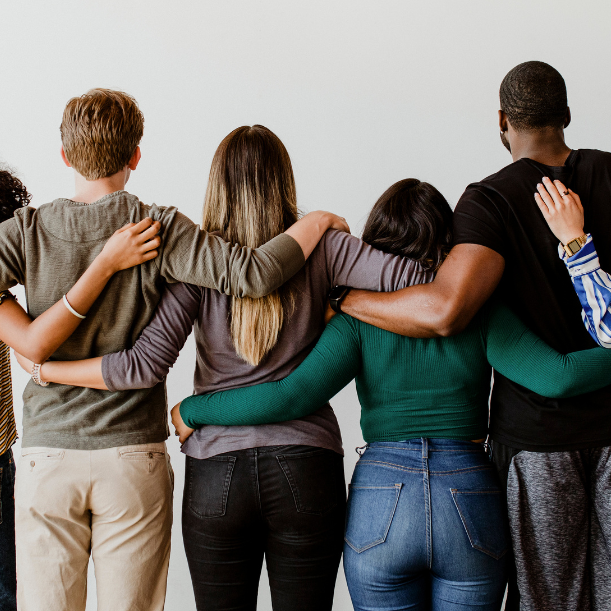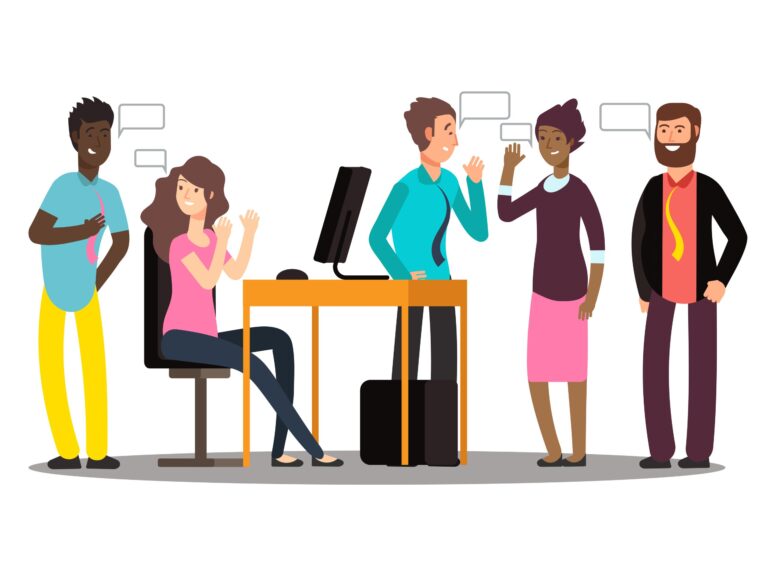Inclusive hiring isn’t just a buzzword; it’s a deliberate, proactive way to rethink your entire recruitment process. At its core, it’s about systematically dismantling the barriers that keep underrepresented talent from walking through your door. The goal is to design a fair, equitable, and accessible process for everyone, ensuring you hire the absolute best person for the job based on their skills and potential—not their background.
Why Inclusive Hiring Practices Matter for Your Business
Let’s get real. Inclusive hiring is far more than a box-ticking exercise for compliance or a nice-to-have for your company’s image. It’s a powerful business strategy that gives you a serious competitive advantage. When you consciously build teams that reflect the rich diversity of society, you unlock tangible benefits that hit the bottom line. Think of it as upgrading your company’s entire operating system. Diverse teams bring fresh perspectives, challenge outdated thinking, and find solutions that homogenous groups would likely miss.
This approach is about creating an environment where every qualified candidate—regardless of their gender, ethnicity, age, disability, sexual orientation, or socioeconomic status—has a genuine opportunity to shine.
The Tangible Business Impact
When you embed inclusion into your hiring, it creates a positive ripple effect across the entire organisation. The benefits aren’t just theoretical; they are measurable and deeply impactful.
- Greater Innovation: Diverse teams are proven to be more innovative. A mix of life experiences and viewpoints naturally leads to more creative problem-solving and out-of-the-box thinking.
- Improved Financial Performance: Time and again, research shows that companies with more diverse leadership and workforces financially outperform their less diverse competitors.
- Enhanced Employer Brand: Today’s top talent actively seeks out workplaces that truly value diversity and inclusion. A strong, authentic commitment to these principles makes you an employer of choice.
In the Indian market, this shift is gathering serious momentum. Companies are realising that to thrive, they must attract talent from every part of the population. For example, despite people with disabilities making up about 2.21% of India’s population, they represent only around 1% of the workforce. This highlights a vast, untapped talent pool. Forward-thinking organisations are now setting specific recruitment goals, driven by frameworks like the Rights of Persons with Disabilities Act, 2016, to close this gap. You can explore more vital workplace statistics and trends on Built In.
To give you a clearer picture, let’s break down the core components of an inclusive hiring strategy.
The Pillars of Inclusive Hiring
This table outlines the essential components of an effective inclusive hiring strategy, giving you a quick overview of the key areas we’ll explore in this guide.
| Pillar | Objective | Key Action |
|---|---|---|
| Policy & Strategy | To build a foundational commitment to diversity, equity, and inclusion (DEI). | Develop clear DEI goals and integrate them into the overall business strategy. |
| Job Descriptions | To attract a diverse applicant pool by eliminating biased language. | Use gender-neutral language and focus strictly on essential skills and qualifications. |
| Sourcing Channels | To reach underrepresented talent pools beyond traditional networks. | Partner with diversity-focused job boards, community groups, and universities. |
| Interview Process | To ensure fair and consistent evaluation for all candidates. | Implement structured interviews with standardised questions and scoring rubrics. |
| Bias Mitigation | To reduce the impact of unconscious bias on hiring decisions. | Conduct regular unconscious bias training for all hiring managers and interviewers. |
| Metrics & Analytics | To track progress, identify gaps, and refine the strategy over time. | Analyse hiring data across different demographics at each stage of the funnel. |
Each of these pillars works together to create a hiring process that is not only fair but also incredibly effective at identifying top talent.
Moving From Compliance to Culture
The most successful companies see inclusive hiring not as a mandate but as a cultural cornerstone. It’s a move away from just meeting diversity quotas to building a genuine sense of belonging for everyone. This involves everything from training hiring managers to recognise their own unconscious biases to making sure job descriptions use language that welcomes all.
True inclusion isn’t just about inviting different people to the party; it’s about making sure everyone feels comfortable enough to dance. It’s an active, ongoing commitment to equity at every step.
This commitment also means creating a supportive environment for all communities. To build a genuinely inclusive culture, you have to focus on specific initiatives that empower groups who have been historically marginalised. Our detailed guide on empowering LGBTQ+ hiring in India offers practical strategies for creating a workplace where everyone feels welcome.
Ultimately, inclusive hiring practices are the foundation upon which a resilient, innovative, and high-performing organisation is built.
Building Your Foundation for Inclusive Recruitment
To really move the needle on your hiring outcomes, you have to know your starting point. You can’t build effective, inclusive hiring practices on assumptions. It all starts with a clear-eyed assessment of where you are right now, taking an honest look at your current processes to find those hidden biases and systemic roadblocks that might be filtering out exceptional talent without you even realising it.
Think of it as a health check-up for your recruitment engine. You need to diagnose the issues before you can prescribe the right solutions. Vague mission statements just won’t cut it; this foundational stage is all about committing to real actions and measurable change.
Auditing Your Current Hiring Process
First things first: you need to conduct a thorough audit of every single stage of your talent acquisition funnel. This isn’t about pointing fingers. It’s about spotting opportunities for improvement. The goal here is to see your process through the eyes of diverse candidates and pinpoint exactly where friction or bias might be creeping in.
Start by mapping out the entire candidate journey, from the moment a job is posted to a new hire’s first day. Ask yourself some tough questions at each step:
- Sourcing: Where are our candidates actually coming from? Are we just leaning on the same few channels that keep giving us similar profiles?
- Application: Is our application process genuinely accessible to people with disabilities? Can someone easily apply from their mobile, or is it a clunky, frustrating experience?
- Screening: Who’s reviewing the résumés? Have they been trained to look past surface-level details like names or university prestige and zero in on actual skills?
- Interviewing: Are we using structured interviews with the same core questions for every candidate? Who is on our interview panels, and do they bring a mix of perspectives to the table?
- Selection: How do we make the final call? Is it based on a “gut feeling,” or are we using objective, skill-based evidence we gathered throughout the process?
This kind of audit will likely reveal patterns you hadn’t noticed before. For example, you might find that your employee referral programme—while well-intentioned—is mostly bringing in candidates from the same demographic as your current team, accidentally working against your diversity goals.
Establishing a DEI Council and Setting Goals
An audit gives you the data, but a dedicated team gives you the momentum. Forming a Diversity, Equity, and Inclusion (DEI) council is a fantastic way to ensure this work has real teeth and isn’t just seen as another HR initiative. This council should be made up of passionate champions from different departments, levels, and backgrounds across the organisation.
The real job of a DEI council is to champion change from within. It’s what moves inclusion from a talking point in a meeting to a lived reality across the organisation, creating accountability and driving progress.
With your council assembled, the next step is to set clear, measurable, and realistic goals that are directly informed by what your audit uncovered. Ditch broad statements like “we want to hire more diversely” and create specific, actionable objectives instead.
Examples of Actionable DEI Goals:
- Increase the percentage of women in our tech leadership pipeline by 15% within the next 18 months.
- Ensure at least 50% of interview panels for senior roles include representation from more than one gender by the end of next quarter.
- Achieve a 10% year-on-year increase in applications from candidates who identify as persons with disabilities.
This infographic shows how these foundational efforts in inclusive hiring directly contribute to organisational success.
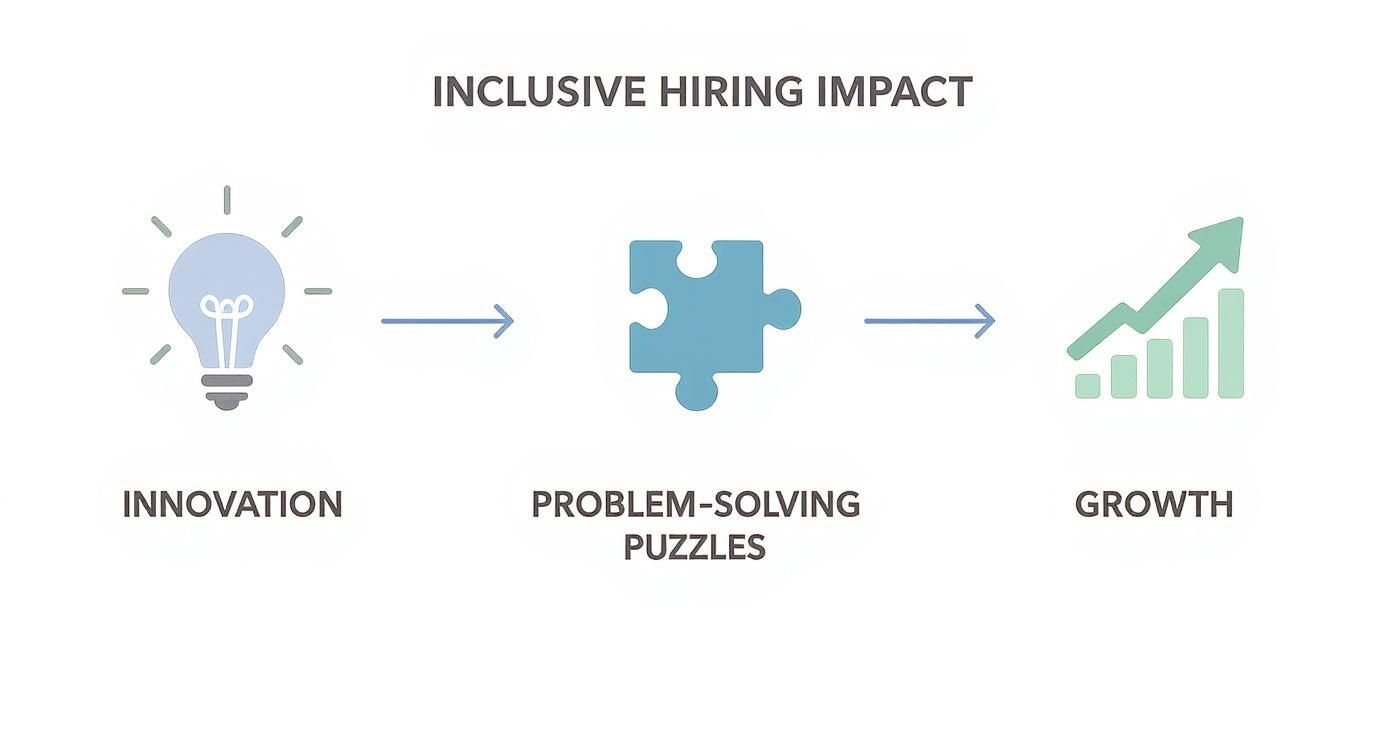
As you can see, a genuine commitment to these practices is what fuels the innovation and problem-solving capabilities essential for long-term business growth.
Redefining Your Employer Value Proposition
Finally, take all these insights and use them to sharpen your Employer Value Proposition (EVP). Your EVP is the promise you make to your employees about the experience of working with you. An inclusive EVP goes way beyond salary and benefits; it shines a light on the policies that truly matter to a diverse workforce.
Many leading Indian companies have successfully revamped their EVPs to attract a much wider range of candidates. They’ve done this by transforming their policies on flexible work, expanding parental leave to be gender-neutral, and investing heavily in making their physical and digital workplaces fully accessible. Highlighting these commitments in your job descriptions and on your careers page sends a powerful message: this is a place where everyone can truly thrive.
Writing Job Descriptions That Attract Everyone

Think of your job description as the front door to your company. For most candidates, it’s the very first interaction they’ll have with you. It’s far more than a simple list of tasks; it’s a handshake, an introduction to your culture and what you stand for. Get it wrong, and you might accidentally slam that door on incredible talent before they even think about applying.
Crafting a truly inclusive job post is a cornerstone of any effective inclusive hiring practice. It’s not about being politically correct—it’s about being clear, precise, and opening your talent pool as wide as possible. This means taking a conscious look at your wording to remove hidden barriers and actively signal that you welcome people from all walks of life.
Ditch the Biased Language and Corporate Jargon
The words we choose matter. They have a powerful, often subconscious, impact on who feels welcome to apply. Research consistently shows that certain words carry gendered undertones, subtly discouraging highly qualified people from even considering a role. Aggressive or competitive terms like “rockstar,” “ninja,” or “dominate” are classic examples that often read as masculine and can deter women.
It’s the same story with corporate jargon and acronyms. A brilliant candidate from another industry might possess every skill you need, but if they can’t decipher your internal terminology, the role can feel inaccessible. You’re creating an unnecessary barrier.
Before: “We are looking for a competitive sales ninja to dominate the market and crush quotas. The ideal candidate will be a strong leader who can manage a young, high-energy team.”
After: “We are seeking a motivated Sales Manager to drive market growth and achieve ambitious targets. The ideal candidate will be an effective leader skilled in guiding and developing a dynamic team.”
Your goal is to describe the role, not a personality type. Focus on the actual skills and responsibilities required to succeed. Using clear, straightforward language that everyone can understand can dramatically change who feels confident enough to apply.
Rethink Your ‘Must-Have’ Requirements
One of the biggest pitfalls in writing job descriptions is creating an endless laundry list of “required” qualifications. We’ve all seen them: demands for “10+ years of experience with X software” or skills that are nice to have but hardly essential for success.
These rigid lists disproportionately screen out amazing talent. For instance, studies show that women and people from underrepresented groups are far more likely to hold back if they don’t meet 100% of the criteria, while others might apply even if they only tick most of the boxes.
Here’s how to fix it:
- Audit Your List: Go through each requirement and ask yourself, “Is this absolutely critical from day one, or is it something a smart person can learn on the job?”
- Separate Essentials from Desirables: Be explicit. Create two distinct sections: “Required Qualifications” and “Preferred Qualifications.”
- Focus on Outcomes: Instead of listing specific tools, describe the problems the candidate will be solving. For example, rather than demanding “Expert in Salesforce,” try “Experience managing a client database to track leads and sales funnels.”
This simple shift invites a much wider range of candidates who have the core skills to excel, even if their CV doesn’t perfectly match a predefined checklist.
Spotlight Inclusive Benefits and Accessibility
Your job description is prime real estate to show, not just tell, that you’re committed to an inclusive workplace. Don’t hide your best policies at the bottom of the page—make them a headline feature.
Explicitly mention things like flexible working hours, remote work options, gender-neutral parental leave, and mental health support. These aren’t just perks; they’re powerful signals that you care about your people’s well-being. It’s also vital to include a clear statement about your commitment to providing accommodations for candidates with disabilities during the hiring process.
Finally, don’t forget technical accessibility. Ensure your job postings are formatted with clear headings (H1, H2, etc.) and have descriptive alt-text for any images. This small step ensures the post is easily navigable for candidates using screen readers, giving everyone equal access to the opportunity.
How to Find and Engage Diverse Talent Pools
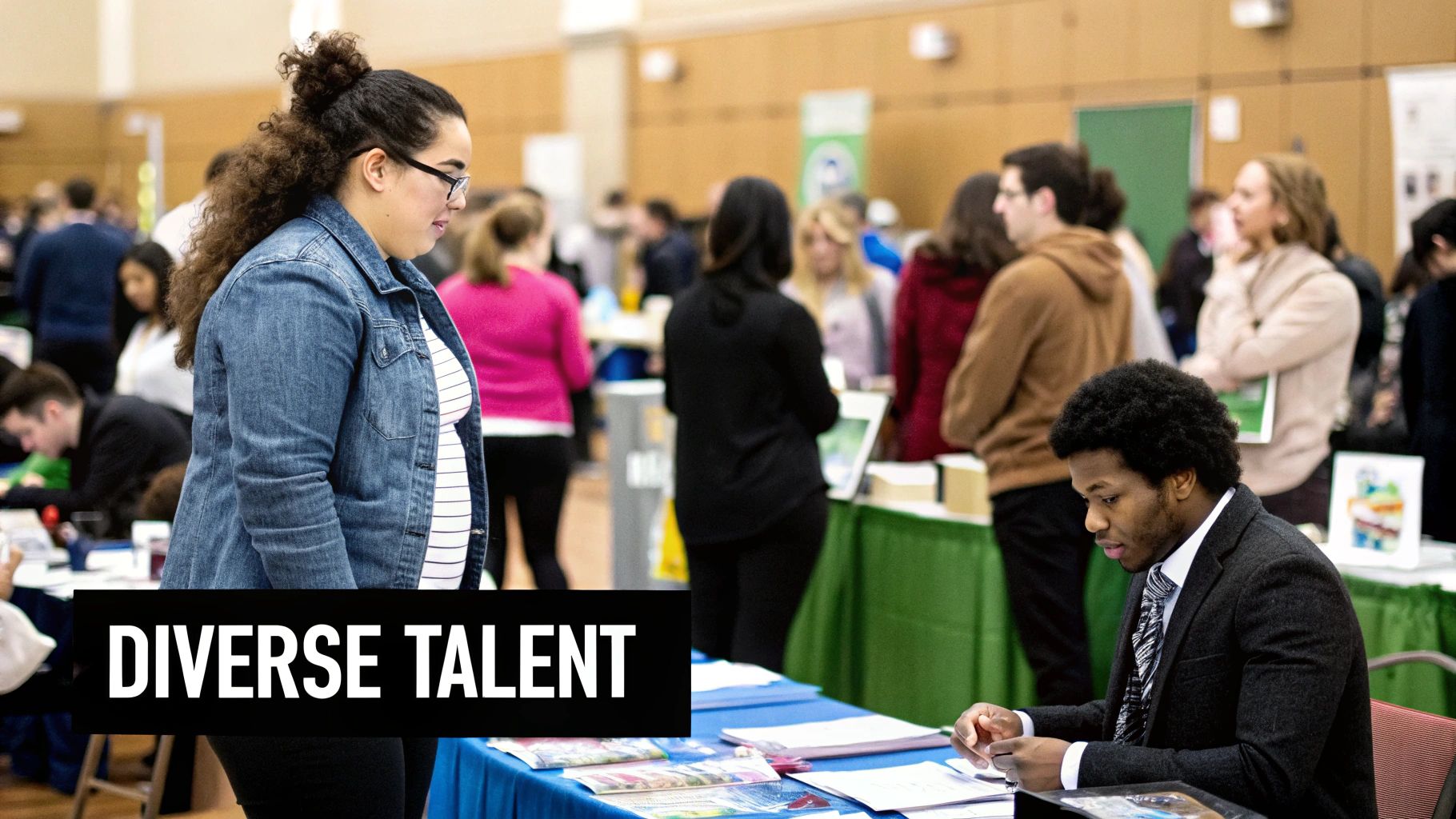
If you want to build a genuinely diverse team, you have to start looking in new places. It’s a simple truth. Relying on the same old job boards and recruitment channels will, without fail, bring you the same old results.
The real key to unlocking a wider, more varied talent pool is to get out of your sourcing comfort zone. This isn’t a passive exercise; inclusive hiring practices demand a proactive, intentional strategy. It’s about consciously seeking out and building relationships with communities that are underrepresented in your current workforce, meeting them where they are, and showing a commitment that lasts longer than a single job post.
Go Beyond Standard Job Boards
Posting a role on a major job portal is the bare minimum. To truly move the needle on diversity, you need to expand your reach to more focused, community-driven platforms where you can connect with candidates who aren’t necessarily scrolling through mainstream sites.
Think about these alternatives:
- Diversity-Focused Hiring Platforms: Partner up with job boards in India that are built specifically for women, persons with disabilities, the LGBTQ+ community, or veterans. These platforms give you a direct line to the talent you’re looking for.
- Community Organisations and NGOs: Don’t just show up when you have a vacancy. Build genuine, long-term relationships with non-governmental organisations that support marginalised communities. Partnering with them on hiring drives or workshops can create a powerful and sustainable talent pipeline.
- University Partnerships: Cast a wider net than just the top-tier institutes. Collaborate with women’s colleges, regional universities, and institutions known for their diverse student bodies to connect with the next generation of talent.
This approach takes more legwork than the “post and pray” method, but the payoff is a much richer, more dynamic group of applicants that will strengthen your organisation from the inside out.
Supercharge Your Employee Referral Programme
Employee referrals are fantastic, but they can easily become an echo chamber. When employees naturally refer people from their own circles, you run the risk of just cloning your existing workforce demographics.
A referral programme should be a tool for diversification, not just replication. By intentionally incentivising referrals from underrepresented groups, you turn your employees into powerful champions for your inclusion goals.
To transform your programme into a real driver of diversity, add a specific incentive. Offer an extra bonus for referrals of candidates from underrepresented backgrounds that result in a hire. This simple tweak encourages your team to think more broadly, tapping into networks you might never have reached otherwise.
The push for inclusive hiring in India has come a long way, driven by both legislation like the Rights of Persons with Disabilities Act, 2016, and a sharper corporate focus on its benefits. Over the last decade, we’ve seen a clear shift. Companies are increasingly adopting affirmative hiring practices, leading to a 12% rise in employment among disadvantaged social groups between 2015 and 2023. Major firms like Infosys have reported significant growth in their workforce diversity, showing what’s possible with focused effort.
Crafting Resonant Outreach Messages
Once you’ve found promising candidates, your first impression has to count. A generic, copy-pasted LinkedIn message is a surefire way to get ignored. Your outreach needs to be thoughtful, personal, and signal that you see and value what makes each person unique.
Personalise your messages. Reference specific skills or projects from their profile that caught your eye. More importantly, use inclusive language and subtly showcase your company’s D&I commitment. Mention your employee resource groups, flexible work policies, or any recent diversity awards.
For certain fields, like tech, it’s vital to address specific barriers. Our guide on how to close the talent gap by hiring women in tech offers some great, actionable advice on this. This kind of authentic approach shows you’ve done your homework and are genuinely interested in them, making them far more likely to respond.
Designing a Fair and Unbiased Interview Process
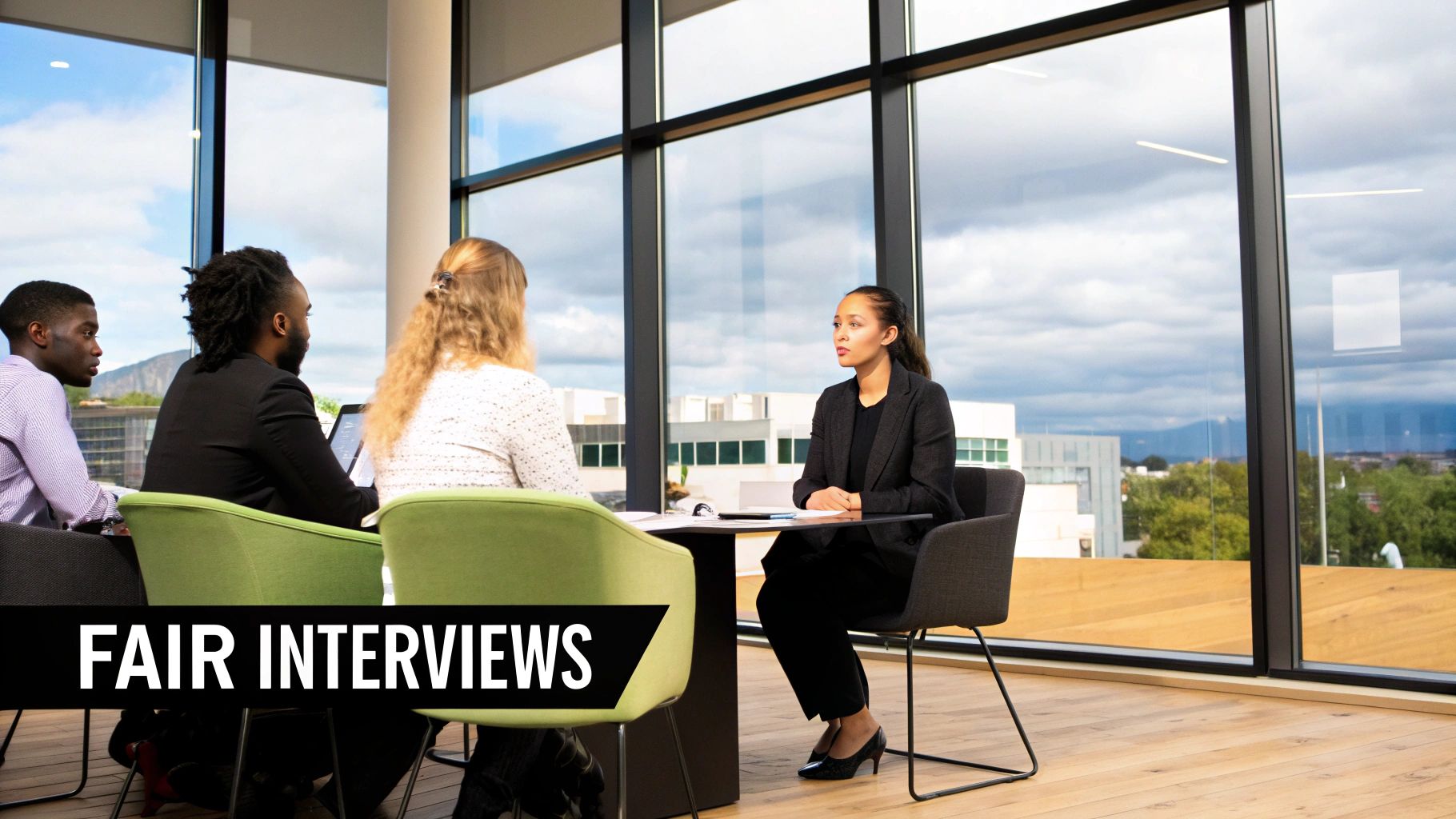
The interview is where all your careful work on inclusive sourcing and job descriptions can fall apart in an instant. It’s the most human-centric part of hiring, which, unfortunately, also makes it the most susceptible to the quiet creep of unconscious bias.
This is the stage where “gut feeling” decisions often take over, pushing aside brilliant candidates for reasons that have nothing to do with their ability to excel in the role.
To build a hiring system that’s genuinely equitable, you have to rethink your interview process from the ground up. The aim is to create a system that’s consistent, fair, and laser-focused on assessing a candidate’s actual skills and potential. In my experience, effective inclusive hiring practices mean ditching the unstructured chats for a much more deliberate, evidence-based approach.
Implement Structured Interviews
If there’s one change that makes the biggest impact, it’s this: switch to structured interviews.
This simply means that every single candidate for a particular role gets asked the exact same set of pre-planned, skills-based questions, in the same order. This standardisation is critical. It creates a level playing field and ensures you’re comparing apples to apples, not apples to oranges.
Instead of throwing out vague questions like, “So, tell me about yourself,” which are just invitations for biased interpretations, structured interviews zero in on competency. The questions are specifically designed to test for the skills and behaviours you know are needed for success.
Let’s say you’re hiring a project manager. Your questions might look something like this:
- Behavioural Question: “Describe a time a project was at risk of missing its deadline. What specific steps did you take to get it back on track?”
- Situational Question: “Imagine you’ve just been assigned a project where two key stakeholders have conflicting priorities. How would you approach your first meeting with them?”
This approach forces interviewers to ground their assessments in concrete evidence of past performance and future potential, rather than how much they “vibed” with the candidate.
Assemble Diverse Interview Panels
Who sits on the other side of the table matters—a lot. A homogenous interview panel is practically a breeding ground for affinity bias, which is our natural tendency to gravitate toward people who remind us of ourselves. It happens without anyone even noticing.
By putting together a diverse panel—with people from different genders, ethnicities, departments, and seniority levels—you automatically introduce a wider range of perspectives. This creates a natural system of checks and balances that helps water down individual biases. An assumption made by one panellist might be questioned or viewed through a different lens by another, leading to a much more holistic and fair evaluation.
When you have a diverse group of people evaluating a candidate, you are less likely to hire for ‘fit’ in a way that just means ‘someone like us.’ Instead, you start to assess for a ‘culture add’—someone who brings a new and valuable perspective to the team.
This doesn’t just lead to smarter hiring choices; it also sends a powerful message to candidates that you’re serious about inclusion. It shows them they’re potentially joining a team where different voices are actually heard and valued.
Train for Bias Awareness
Of course, just getting a diverse group of people in a room isn’t a magic bullet. You have to give them the tools to succeed. Unconscious bias training is non-negotiable for anyone involved in hiring.
This isn’t about shaming people for having biases—we all have them. It’s about making people aware of the common mental shortcuts we take and giving them practical strategies to counteract them.
Good training should cover the greatest hits of bias, like:
- Confirmation Bias: The habit of seeking out information that confirms what we already believe.
- Halo/Horns Effect: Letting one really great (or really bad) trait colour your entire perception of a candidate.
- Stereotyping: Making broad assumptions about someone based on a group they belong to.
The best training programmes are interactive and use real-world scenarios that are relevant to your company. The goal is to give your interviewers the vocabulary and confidence to spot and challenge bias, both in themselves and in their colleagues.
Focus on Skills, Not ‘Cultural Fit’
Let’s be honest: “cultural fit” has become a dangerously vague excuse in the corporate world. Too often, it’s used to justify rejecting candidates who don’t fit a very narrow, pre-existing mould. It becomes a stand-in for “this person doesn’t look or talk like the rest of us.”
It’s time to shift your focus from this fuzzy idea to something far more concrete: values alignment and skills assessment.
First, assess if a candidate’s professional values—like a commitment to collaboration or a drive for continuous learning—resonate with your company’s core principles. More importantly, use skills-based assessments or work sample tests to get objective data on their abilities.
For a software developer, this could be a short coding challenge. For a content writer, a quick editing test. These practical tasks provide clear, empirical proof of a candidate’s ability to do the job, pulling the final decision away from subjective feelings and firmly into the realm of proven skill.
How to Measure and Improve Your Hiring Practices
Inclusive hiring isn’t a “one-and-done” project. Think of it as a continuous cycle: you act, you measure, you refine, and you repeat. To really know if your hard work is paying off, you have to move beyond good intentions and get comfortable with data. Tracking the right metrics is how you find out what’s working, spot hidden roadblocks, and get the proof you need to make smarter hiring decisions.
This is where you see the real-world impact of your efforts, turning ambitious goals into tangible outcomes you can actually see, share, and build on.
Identifying Your Key Performance Indicators
To get going, concentrate on metrics that give you a clear, unobstructed view of your entire hiring funnel. Don’t just skip to the final hiring numbers; you need to analyse the diversity of your applicant pipeline at every single stage. An Applicant Tracking System (ATS) is pretty much essential here, letting you gather and slice the data without drowning in spreadsheets.
Here are the vital signs you should be monitoring:
- Pipeline Diversity: What’s the demographic breakdown of candidates at the application, screening, interview, and offer stages? If you see a big drop-off at a specific point, that’s a huge red flag for potential bias in your process.
- Offer Acceptance Rates: Are acceptance rates consistent across different demographic groups? A noticeable gap might tell you that something about your offer, or even the final interview stage, isn’t connecting with certain candidates.
- New Hire Retention: How long do new hires from underrepresented groups stay with the company compared to everyone else? Poor retention can be a sign that your workplace culture needs just as much work as your hiring process.
- Source of Hire: Which channels are actually bringing in the most diverse candidates? This data is pure gold—it tells you exactly where to double down on your sourcing efforts.
The Indian IT sector is a great example of how deliberate tracking can drive real change. With around 52% of large IT firms now using structured diversity metrics, female representation in tech roles has leaped from about 18% in 2010 to nearly 35% in 2023. These companies prove that what gets measured, gets managed. You can find more insights into these kinds of workplace diversity statistics on SelectSoftware Reviews.
Gathering Qualitative Feedback
Numbers tell a crucial part of the story, but they can’t tell you everything. To understand the why behind your data, you absolutely must collect qualitative feedback. This is the human element that gives context to the cold, hard facts.
Data will show you if you have a leak in your pipeline. Candidate feedback will tell you exactly where the hole is and how to patch it.
Set up simple, anonymous surveys for both your new hires and the candidates who didn’t get an offer. Ask them about their experience—with the application, the interviewers, the communication, everything. This feedback is invaluable. It gives you honest, direct insights into how your process feels from the outside, allowing you to make targeted fixes that improve the candidate journey for everyone. For a fantastic real-world example of this in action, check out our case study on how OYO Rooms experienced a big lift in hiring metrics.
Creating a Cycle of Continuous Improvement
Finally, take this powerful mix of quantitative data and qualitative stories to create a feedback loop. Schedule regular reviews—quarterly is a good rhythm—with your hiring managers and DEI council. In these meetings, you’ll go over the numbers and talk through the feedback you’ve received.
This isn’t about blaming anyone. It’s about collaborative problem-solving. Celebrate what’s going well, have open conversations about the challenges, and adjust your strategy based on what you’ve learned. This ongoing process of measuring, learning, and refining is what truly embeds inclusive hiring into your company’s DNA.








